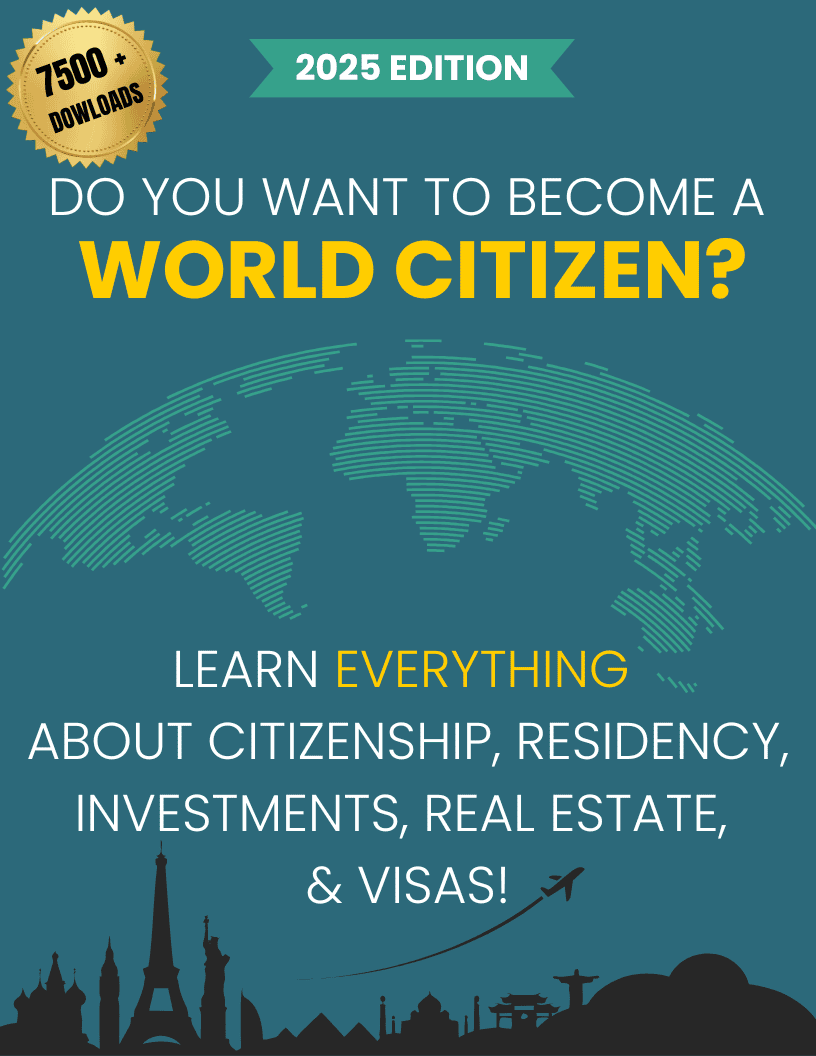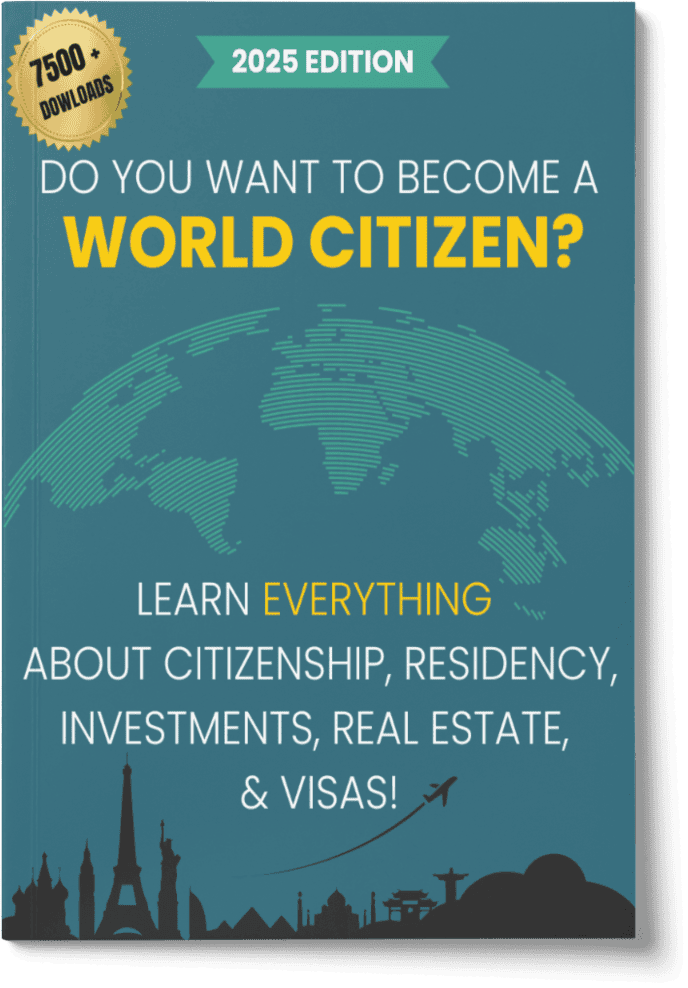EB-1 Visa
Boost Your Freedom Without Compromise.
- Who offers the CHEAPEST program available.
- Who offers the BEST program available.
- What you need to qualify?

In This Article, You Will Discover:
- The EB-1 visa is for individuals with extraordinary ability in the sciences, arts, education, business, or athletics, outstanding professors and researchers, and certain multinational executives and managers.
- Benefits include a fast track to U.S. permanent residency, no labor certification requirement, and priority processing compared to other employment-based visa categories.
- Applicants must demonstrate extraordinary ability through sustained national or international acclaim, with evidence like awards, publications, and significant contributions to their field.
- Dependents, including spouse and children under 21, can accompany the holder to the U.S. under derivative status.
- It serves as a direct path to obtaining a Green Card, with eligibility for permanent residency often faster than other visa categories.
Dreaming of living and working in the United States under the prestigious EB-1 visa? You’re not alone—and that’s the problem.
Demand for this elite immigration route is soaring, and all EB-1 visas for FY 2024 were exhausted months before the year ended, with new allocations available from October 1, 2024.1 With long waits, complex eligibility rules, and intense competition, navigating this visa route requires more than just impressive credentials.
In this article put together by the WorldPassports team, you'll learn exactly what it takes to qualify, why timing is everything, and the steps you must follow to improve your chances of success.
Continue reading to navigate the complexities of the EB-1 visa and enhance your chances of a successful application…
- Who offers the CHEAPEST program available.
- Who offers the BEST program available.
- What you need to qualify?
 Free Consultation
Free Consultation Easy to Use
Easy to Use 100% Safe & Secure
100% Safe & Secure
What Are the Types of EB-1 Visa Categories?
The types of EB-1 visa categories include EB-1A for individuals with extraordinary ability, EB-1B for outstanding professors and researchers, and EB-1C for multinational executives and managers.
Here’s what you need to know about EB-1 Visas:
What is the EB-1 Visa?
The EB-1 visa is a first-preference employment-based immigrant visa for individuals who demonstrate extraordinary ability in their field, are outstanding professors or researchers, or are multinational executives or managers.
It typically offers a pathway to U.S. permanent residency (a green card) without requiring employer sponsorship in certain cases, making it one of the fastest and most prestigious U.S. immigration options.
Let’s look a little closer:
Why the EB-1 Visa Is a Popular Option in 2025
The EB-1 visa remains a popular option in 2025 due to its faster processing times, high success rates for qualified applicants, and the ability to bypass the labour certification process.
As global competition for top talent increases, this visa offers a direct route to permanent residency for individuals with exceptional achievements, making it particularly appealing for professionals in science, academia, business, and the arts.
Who Should Consider Applying?
Highly accomplished individuals—such as researchers, executives, and professionals with national or international recognition in their field—should consider applying for the EB-1 visa.
It is best suited to those who can clearly demonstrate sustained excellence through awards, publications, patents, leadership roles, or other recognised achievements.
What Is the EB-1A for Individuals With Extraordinary Ability?
The EB-1A is a subcategory of the EB-1 visa designed for individuals who can demonstrate extraordinary ability in fields such as science, arts, education, business, or athletics.
Applicants must show sustained national or international acclaim through a strong portfolio of achievements and can self-petition without a job offer or employer sponsorship.
What Is the EB-1B for Outstanding Professors & Researchers?
The EB-1B category is intended for outstanding professors and researchers who have at least 3 years of experience in teaching or research and are internationally recognised in their academic field.
Unlike the EB-1A, this visa requires a permanent job offer from a U.S. university or qualifying employer and proof of scholarly accomplishments.
What Is the EB-1C for Multinational Executives & Managers?
The EB-1C is aimed at multinational executives or managers who have worked for a qualifying foreign company for at least 1 of the past 3 years and are being transferred to a related U.S. entity.
This category requires an employer-sponsored petition and is commonly used by international businesses expanding their operations into the United States.
What Are the Eligibility Requirements for the EB-1 Visa?
The eligibility requirements for the EB-1 visa depend on the category but generally demand evidence of exceptional achievements, international recognition, or a qualifying executive or managerial role in a multinational company.
Here's what you need to know:
What Are the General Qualifications for Each Category?
The EB-1 visa is divided into 3 subcategories; all 3 require evidence of sustained national or international acclaim or expertise, and each has distinct eligibility criteria: EB-1A (Extraordinary Ability), EB-1B (Outstanding Professors and Researchers), and EB-1C (Multinational Executives and Managers).
The EB-1A category is for individuals with extraordinary ability in sciences, arts, education, business, or athletics; you must demonstrate sustained acclaim and that you’re coming to the U.S. to continue working in your field. No job offer or labor certification is needed.
The EB-1B is for professors and researchers with at least 3 years of experience; applicants must be recognized internationally as outstanding in their academic area and have a permanent research or teaching job offer from a U.S. institution.
Finally
The EB-1C category targets executives and managers employed for at least one of the past 3 years by a multinational company, and the U.S. job must also be in a managerial or executive capacity, and the petitioning employer must have a qualifying relationship with the overseas business.
How Can You Prove Extraordinary Ability or Expertise?
To prove extraordinary ability or expertise under EB-1A, you must provide evidence of a one-time major achievement (like a Pulitzer, Oscar, or Olympic Medal), or meet at least 3 of ten criteria set by USCIS, which include lesser nationally or internationally recognized prizes, published material, and high salary.
Each criterion must demonstrate that your ability is significantly above that normally encountered, for instance, original contributions of major significance or authorship of scholarly articles in professional publications are strong indicators of extraordinary ability.
For EB-1B, proof of international recognition and original research contributions is essential; peer-reviewed publications, participation as a judge of others’ work, and awards from recognized academic bodies support your case.
In the EB-1C route, applicants should show they directed major company functions, oversaw employees or departments, and made high-level decisions. Organizational charts, performance reviews, and corporate job descriptions are often used as proof.
What Supporting Documents Are Typically Required?
Each EB-1 petition typically required documents that include a completed Form I-140 (Immigrant Petition for Alien Worker) filed with USCIS; the form must be accompanied by evidence tailored to the specific subcategory.
Additionally, all documents should be translated into English if not already in English, and certified as accurate translations.
Typical supporting documents for EB-1A include:
- Evidence of major awards or nominations.
- Press coverage and published material about your work.
- Letters of recommendation from field experts.
- Membership in associations requiring outstanding achievements.
For EB-1B, common documents include:
- Employer job offer letter.
- Proof of teaching or research experience.
- Academic publications and citation indexes.
- Documentation of awards and funded research.
EB-1C applicants generally provide:
- Organizational charts and business registration documents.
- Job descriptions and employment records.
- Letters verifying executive or managerial roles abroad and in the U.S.
- Proof of the corporate relationship between the U.S. entity and foreign affiliate.
What Does the EB-1 Visa Application Process Look Like?
The EB-1 visa application process involves gathering extensive evidence, submitting Form I-140 (Immigrant Petition for Alien Workers), and either adjusting status in the US or attending a consular interview abroad.
What Are the Step-by-Step Application Stages?
The step-by-step application stages for an EB-1 visa include determining your eligibility under the EB-1A, EB-1B or EB-1C category, gathering supporting evidence, and filing Form I-140 with USCIS.
Each stage must be handled precisely, with no missing documentation or errors, to avoid delays or denials.
Here’s a step-by-step breakdown:
- Determine Eligibility: Identify which EB-1 subcategory best matches your background and gather relevant documentation.
- File Form I-140: Submit this immigrant petition to USCIS with fees and evidence. EB-1A applicants can self-petition, while EB-1B and EB-1C require employer sponsorship.
- Await USCIS Decision: Processing times vary, though Premium Processing can speed this up for some subcategories.
- Apply for Green Card:
- Inside the U.S.: File Form I-485 (Adjustment of Status).
- Outside the U.S.: Complete consular processing with Form DS-260 and attend a visa interview.
- Inside the U.S.: File Form I-485 (Adjustment of Status).
- Attend Biometrics and Interview: USCIS may require a biometric screening and, in some cases, an interview.
- Receive Decision: If approved, applicants receive lawful permanent resident status.
Do You Need a Job Offer or Employer Sponsorship?
A job offer or employer sponsorship is not required for the EB-1A visa; iIndividuals can self-petition by proving extraordinary ability and intent to continue working in their field.
EB-1B and EB-1C applicants do need a valid job offer from a U.S. employer, though, and the employer must file Form I-140 on the applicant’s behalf while the job must meet strict requirements related to academic or managerial duties.
The job offer must be permanent and full-time, especially in the EB-1C category, where the role must mirror the managerial or executive position held abroad.
How Long Does the Process Usually Take?
Processing times vary by subcategory and applicant location, though checking the USCIS Processing Times page and the Visa Bulletin is essential for accurate updates.
Overall, the full process—from petition to green card—may take 12–24 months, but times fluctuate based on caseloads and individual circumstances.
On average, the I-140 petition takes:
- 6–8 months for standard processing.
- 15 calendar days if Premium Processing is used (available for EB-1A and EB-1B).
After I-140 approval:
- Adjustment of Status (Form I-485) takes 8–14 months, depending on the USCIS field office.
- Consular Processing may take 6–12 months, depending on embassy schedules and background checks.
What Are the Costs & Fees Associated With the EB-1 Visa?
The costs and fees associated with the EB-1 visa typically include USCIS filing fees for Form I-140, premium processing fees if chosen, legal representation costs, and additional consular or adjustment of status fees.
What Are the Filing Fees?
As of 2025, the main EB-1 visa filing fee is for Form I-140, which costs $715 which is paid to U.S. Citizenship and Immigration Services (USCIS) when submitting your immigrant petition; if going through consular processing, the DS-260 application fee is $325, plus a $220 USCIS Immigrant Fee payable after visa approval.
If you’re adjusting status from within the U.S., Form I-485 costs $1,440 for adults and $950 for children under 14 filing with a parent; this includes biometric fees in most cases.
Optional Premium Processing for EB-1A and EB-1B costs $2,805, offering a response from USCIS within 15 calendar days. EB-1C applicants currently cannot access this expedited service.
Are There Any Hidden or Additional Expenses?
While not “hidden,” there are additional expenses that can add several hundred dollars to your total outlay, so always plan ahead and verify prices with the service providers involved.
Beyond USCIS filing fees, EB-1 applicants should budget for several additional costs:
- Medical exams for green card applicants: typically $200–$500, depending on provider and region.
- Document translation and certification fees for non-English materials.
- Travel expenses for attending biometrics appointments or visa interviews abroad.
- Courier and copying charges, especially for extensive supporting evidence packages.
Should You Hire an Immigration Attorney?
Hiring an immigration attorney is not required, but it can be highly beneficial—legal support can reduce the risk of denials, requests for evidence (RFEs), and costly delays, especially for EB-1 petitions, which are evidence-heavy and subject to strict scrutiny.
Attorneys typically charge $3,000 to $7,000 or more depending on the complexity of the case and the EB-1 category; the cost includes preparing forms, advising on supporting documentation, and representing you in correspondence with USCIS.
For EB-1A self-petitioners and EB-1B researchers, a skilled lawyer can help structure the strongest possible petition, especially when documenting exceptional ability or academic contributions.
What Are Some of the EB-1 Visa Benefits & Drawbacks?
Some of the EB-1 visa benefits include quicker green card processing and no need for labour certification, while drawbacks include the high evidentiary standards and intensive documentation required.
Take a look at the pros and cons:
What Are the Key Advantages of the EB-1 Route?
The main key advantage of the EB-1 visa os that it offers priority status, meaning it's one of the fastest employment-based green card routes due to "first preference" classification—this often results in shorter waiting times compared to EB-2 or EB-3 categories.
No PERM labor certification is required for any EB-1 subcategory, saving time, eliminating a major bureaucratic hurdle, and making the process smoother and more predictable.
EB-1A applicants can self-petition, which allows greater independence from employers and is ideal for individuals with high-level achievements who wish to control their own immigration path.
What Challenges Should You Prepare For?
The main challenge you should prepare for is that the eligibility threshold for EB-1 is high—you must prove extraordinary ability, international recognition, or significant managerial experience, which can be difficult to document convincingly.
USCIS applies strict scrutiny to EB-1 petitions; even strong candidates may receive Requests for Evidence (RFEs) if documentation isn’t compelling or well-organized.
For EB-1A applicants, self-petitioning removes the employer requirement but places the burden of proof entirely on the individual, and persuasive evidence is crucial and time-consuming.
In the EB-1C category, showing a qualifying corporate relationship and managerial role often requires detailed business records, which not all companies can easily provide.
Is EB-1 Faster or More Flexible Than Other Visas?
Yes, the EB-1 visa is generally faster and more flexible than many other U.S. visa categories; as a first-preference immigrant visa, it often has “current” priority dates, allowing applicants to move forward without long waits.
It avoids the PERM labor certification process, which can add 12+ months to EB-2 and EB-3 applications, and compared to temporary work visas, EB-1 offers a direct path to a green card, removing the need for future extensions or employer-dependent renewals.
EB-1A’s self-petition option adds flexibility, especially for freelancers, entrepreneurs, or individuals without a U.S. job offer. Unlike H-1B or O-1 visas, no employer sponsorship is needed.
How Can You Maximize Your Chances of Approval?
You can maximize your chances of approval by thoroughly documenting your achievements, working with an experienced immigration lawyer, and tailoring your petition to clearly match EB-1 eligibility criteria.
What Makes a Strong EB-1 Application?
A strong EB-1 application clearly and convincingly demonstrates how the applicant meets or exceeds USCIS’s eligibility criteria; it’s not just about quantity of evidence, but the quality, relevance, and presentation.
In EB-1B and EB-1C cases, supporting evidence must clearly document the prestige of the employer, the applicant’s role and achievements, and how their work stands out in a global context.
A well-organized petition with a detailed cover letter explaining how each document supports a specific criterion can greatly improve chances of approval.
For EB-1A, strong petitions often include:
- National or international awards or prizes with public recognition.
- Media coverage, scholarly articles, or citation evidence proving field impact.
- Original contributions of major significance, such as patents or inventions.
How Can Letters of Recommendation Make a Difference?
Letters of recommendation can make a massive difference in establishing the applicant’s standing in their field, as they provide independent confirmation from experts or peers and are especially impactful in EB-1A and EB-1B petitions.
A well-crafted letter can help explain technical or specialized achievements in plain language, making the application more compelling to USCIS reviewers.
Strong letters should:
- Come from well-respected individuals in the applicant’s field, ideally unaffiliated with them.
- Describe the applicant’s specific contributions, why they are important, and how they have influenced the field.
- Avoid vague praise and instead offer concrete examples of impact.
What Are Common Mistakes to Avoid?
One major and common mistake is submitting insufficient or poorly organized evidence; the USCIS requires documentation tied directly to eligibility criteria, not general achievements.
Applicants often over-rely on job titles or resumes, which aren’t enough to demonstrate “extraordinary ability” or “outstanding” status without detailed proof.
Failing to tailor the petition to the specific EB-1 category also hurts approval chances, as each subcategory has unique requirement, and mixing evidence types can confuse adjudicators.
Other common errors include:
- Weak or generic recommendation letters.
- Outdated or unverifiable documentation.
- Ignoring USCIS’s guidance or not addressing RFEs effectively.
What Are the Alternatives If You Don’t Qualify for EB-1?
Alternatives if you don’t qualify for EB-1 include applying for an EB-2 visa with a National Interest Waiver, an EB-3 visa for skilled workers, or exploring other employment-based or family-based visa categories.
Should You Consider the EB-2 or EB-3 Visa?
Yes you should consider EB-2 and EB-3 visas, as they offer alternative routes to permanent residency if you don’t meet EB-1’s high eligibility threshold; however, these visas require PERM labor certification, meaning the U.S. employer must first test the labor market and confirm no qualified U.S. workers are available.
These visas have lower evidentiary standards but longer waiting times, especially for applicants from countries with high demand like India or China.
Note the following:
- EB-2 is suitable for professionals with advanced degrees or exceptional ability. A National Interest Waiver (NIW) may allow self-petitioning.
- EB-3 is designed for skilled workers, professionals with bachelor’s degrees, or certain unskilled roles.
Are There Other Work or Talent-Based Visa Options?
Yes, there are several other visa types may suit individuals with specialized skills or global recognition.
While these are non-immigrant visas, they may lead to green card options—each has different requirements, durations, and limitations, so professional advice may be helpful.
These visa types include:
- O-1 Visa: For individuals with extraordinary ability in sciences, arts, education, business, or athletics. Temporary, but renewable.
- L-1 Visa: For intracompany transfers of managers or executives (a possible stepping-stone to EB-1C).
- H-1B Visa: For professionals in specialty occupations. Subject to a lottery and annual cap.
- P Visa: For athletes, artists, and entertainers with international recognition.
Can You Reapply or Appeal a Denied EB-1 Visa?
Yes, you can reapply or appeal a denied EB-1 visa by filing an appeal, motion to reopen, or motion to reconsider with USCIS, depending on the grounds for denial—a denial is not final.
Keep this important info in mind:
- Appeals go to the Administrative Appeals Office (AAO) and must be filed within 30 days of the decision.
- A motion to reopen requires new evidence, while a motion to reconsider argues based on an error in law or fact.
Alternatively, you can submit a new EB-1 petition if you strengthen your evidence or address the deficiencies cited in the denial, and many applicants succeed on a second attempt with improved documentation or legal support.
Common Questions
What’s the Approval Rate for EB-1 Visas in 2025?
How Competitive Is the EB-1 Process This Year?
Can You Apply for an EB-1 Visa While Living Outside the U.S.?
Does the EB-1 Lead to a Green Card Automatically?
Can Family Members Join You Under the EB-1 Visa?
What Happens If You Change Jobs After Approval?
How Has the EB-1 Visa Changed in 2025?
In Conclusion
Applying for the EB-1 visa in 2025 can be a life-changing step, but success hinges on preparation and precision.
With high standards and strong competition, it’s vital to present a compelling case that clearly meets USCIS criteria; whether you're an exceptional talent, researcher, or executive, expert guidance can make all the difference.
Take the time to understand the process, gather robust evidence, and seek professional support to strengthen your application.
Ready to move forward? Start your EB-1 journey with confidence by consulting a qualified immigration adviser today.
- Who offers the CHEAPEST program available.
- Who offers the BEST program available.
- What you need to qualify?
 Free Consultation
Free Consultation Easy to Use
Easy to Use 100% Safe & Secure
100% Safe & Secure







